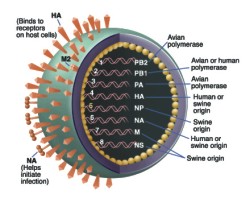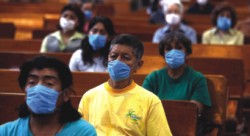Health
The Swine Flu Syndrome
 The swine influenza A (H1N1) virus that has infected humans in many countries has not previously been identified anywhere. This virus is resistant to the antiviral medications amantadine (Symmetrel) and rimantadine (Flumadine), but is sensitive to oseltamivir (Tamiflu) and zanamivir (Relenza). Investigations of these cases suggest that on-going human-to-human swine influenza A (H1N1) virus is occurring. Although uncomplicated influenza-like illness (fever, cough or sore throat) has been reported in many cases, mild respiratory illness (nasal congestion, rhinorrhea) without fever and occasional severe disease also has been reported. Other symptoms reported with swine influenza infection include vomiting, diarrhoea, myalgia, headache, chills, fatigue, and dyspnoea. Conjunctivitis is rare, but has been reported. Severe disease (pneumonia, respiratory failure) and fatal outcomes have been reported with swine influenza. Persons with swine influenza A (H1N1) virus infection should be considered potentially contagious for up to 7 days following illness onset. Persons who continue to be ill longer than 7 days after illness onset should be considered potentially contagious until symptoms have resolved. Children, especially younger children, might potentially be contagious for longer periods. The swine influenza A (H1N1) virus that has infected humans in many countries has not previously been identified anywhere. This virus is resistant to the antiviral medications amantadine (Symmetrel) and rimantadine (Flumadine), but is sensitive to oseltamivir (Tamiflu) and zanamivir (Relenza). Investigations of these cases suggest that on-going human-to-human swine influenza A (H1N1) virus is occurring. Although uncomplicated influenza-like illness (fever, cough or sore throat) has been reported in many cases, mild respiratory illness (nasal congestion, rhinorrhea) without fever and occasional severe disease also has been reported. Other symptoms reported with swine influenza infection include vomiting, diarrhoea, myalgia, headache, chills, fatigue, and dyspnoea. Conjunctivitis is rare, but has been reported. Severe disease (pneumonia, respiratory failure) and fatal outcomes have been reported with swine influenza. Persons with swine influenza A (H1N1) virus infection should be considered potentially contagious for up to 7 days following illness onset. Persons who continue to be ill longer than 7 days after illness onset should be considered potentially contagious until symptoms have resolved. Children, especially younger children, might potentially be contagious for longer periods.
Antiviral chemoprophylaxis (pre-exposure or post-exposure) with either oseltamivir or zanamivir is recommended for the following individuals:
1. Household close contacts who are at high-risk for complications of influenza (persons with certain chronic medical conditions, elderly) of a confirmed or suspected case.
2. School children who are at high-risk for complications of influenza (persons with certain chronic medical conditions) who had close contact (face-to-face) with a confirmed or suspected case.
3. Health care workers or public health workers who had unprotected close contact with an ill confirmed case of swine influenza A (H1N1) virus infection during the case's infectious period.
Any health care worker who is at high-risk for complications of influenza (persons with certain chronic medical conditions, elderly) who is working in an area with confirmed swine influenza A (H1N1) cases, and who is caring for patients with any acute febrile respiratory illness.
Information on the effectiveness of face-masks and respirators for the control of influenza in community settings is extremely limited. Thus, it is difficult to assess their potential effectiveness in controlling swine influenza A (H1N1) virus transmission in these settings. In the absence of clear scientific data, the interim recommendations below have been developed on the basis of public health judgment and the historical use of face-masks and respirators in other settings.
 |
If used correctly, face-masks and respirators may help reduce the risk of getting influenza, but they should be used along with other
preventive measures, such as avoiding close contact and maintaining good hand hygiene. |
In areas with confirmed human cases of swine influenza A (H1N1) virus infection, the risk for infection can be reduced through a combination of actions. No single action will provide complete protection, but an approach combining the following steps can help decrease the likelihood of transmission. These actions include frequent hand-washing, covering coughs, and having ill persons stay home, except to seek medical care, and minimize contact with others in the household. Additional measures that can limit transmission of a new influenza strain include voluntary home quarantine of members of households with confirmed or probable swine influenza cases, reduction of unnecessary social contacts, and avoidance whenever possible of crowded settings.
When it is absolutely necessary to enter a crowded setting or to have close contact with persons who might be ill, the time spent in that setting should be as short as possible. If used correctly, face-masks and respirators may help reduce the risk of getting influenza, but they should be used along with other preventive measures, such as avoiding close contact and maintaining good hand hygiene. A respirator that fits snugly on your face can filter out small particles that can be inhaled around the edges of a face-mask, but compared with a face-mask it is harder to breathe through a respirator for long periods of time.
When crowded settings or close contact with others cannot be avoided, the use of face-masks or respirators in areas where transmission of swine influenza A (H1N1) virus has been confirmed should be considered as follows:
1. Whenever possible, rather than relying on the use of face-masks or respirators, close contact with people who might be ill and being in crowded settings should be avoided.
2. Face-masks should be considered for use by individuals who enter crowded settings, both to protect their nose and mouth from other people's coughs and to reduce the wearers' likelihood of coughing on others; the time spent in crowded settings should be as short as possible.
3. Respirators should be considered for use by individuals for whom close contact with an infectious person is unavoidable. This can include selected individuals who must care for a sick person (e.g., family member with a respiratory infection) at home.
Source: Internet
Copyright
(R) thedailystar.net 2009 |
